Makani Kite System for Creating Electrical Energy
I have been fascinated with the topic of kite powered electrical generation for quite a while.
The first device that I saw that seemed plausible was the Magenn Power Air Rotator System. The Magenn system is proceeding into the development phase now and has some real promise. The Magenn kite, employing the Magnus effect for lift, has come a long way from the first prototype demonstrated to kiters at the Canal Days Kite Festival in Port Colborne, ON in 2006.
 However, for high output power production by a kite, the Makani Power Inc.’s concept looks like it will be a real winner. The Makani kite is currently working in prototype form and is attracting a lot of attention from investors and electrical engineers alike. Flying in an automatically controlled elliptical pattern, much like those performed by dual line sport kites, the Makani power generating kite can seemingly stay aloft for very long periods of time where there are constant prevailing or regularly defined winds, such as along coast lines.
However, for high output power production by a kite, the Makani Power Inc.’s concept looks like it will be a real winner. The Makani kite is currently working in prototype form and is attracting a lot of attention from investors and electrical engineers alike. Flying in an automatically controlled elliptical pattern, much like those performed by dual line sport kites, the Makani power generating kite can seemingly stay aloft for very long periods of time where there are constant prevailing or regularly defined winds, such as along coast lines.
The Makani web site does not provide visual details of the power generating kite system or the kite itself. It has only been revealed in special technology news reports that provide some tantalizing details about the work of Saul Griffiths and his team.
Recently Exchange Magazine, a noted magazine for business, economic and development entrepreneurs did a major piece on the Makani kite-powered generation system.
 Saul Griffith, the leader of the Makani corporation and the Makani kite concept, is one of today's most innovative thinkers. He believes in open source ideas, the power of collaboration and rolling up your sleeves to attempt to create solutions to issues that will benefit society. His ideas have led to lower costs in production of a number of everday items (e.g. prescription eye glasses). He is the founder of the web site Instructables.com which shows how to make an incredible array of interesting and innovative products. Saul is also a regular columnist at Make Magazine.
Saul Griffith, the leader of the Makani corporation and the Makani kite concept, is one of today's most innovative thinkers. He believes in open source ideas, the power of collaboration and rolling up your sleeves to attempt to create solutions to issues that will benefit society. His ideas have led to lower costs in production of a number of everday items (e.g. prescription eye glasses). He is the founder of the web site Instructables.com which shows how to make an incredible array of interesting and innovative products. Saul is also a regular columnist at Make Magazine.
Saul's Makani kite power generation project was featured at the recent TED conference.TED: Technology/Entertainment/Design is a high profile organization that showcases promising new ideas and the innovators that are guiding their development.
 Saul’s presentation to the conference is of particular interest to kiters since he touches on the history of kites (person lifting, traction, development of powered flight) as he leads up to the demonstration footage of the Makani kite in the sky actually flying and generating power. This is very worthwhile viewing for kiters. The link to the video (about 5 minutes of Saul on kites and the Makani system) and a brief backgrounder on Mr. Griffiths is found in two places:
Saul’s presentation to the conference is of particular interest to kiters since he touches on the history of kites (person lifting, traction, development of powered flight) as he leads up to the demonstration footage of the Makani kite in the sky actually flying and generating power. This is very worthwhile viewing for kiters. The link to the video (about 5 minutes of Saul on kites and the Makani system) and a brief backgrounder on Mr. Griffiths is found in two places:
- Exchange Magazine's report and video on the Makani Kite System;
- TED conference report and video on the Makani Kite System.
This is a good high tech kite story and a must-see video for kiters!

Silver Dart Replica Flies to Honour a Century of Aviation in Canada
On Sunday, February 22, 2009 a Silver Dart replica airplane flew successfully at Baddeck, Nova Scotia to mark the end of the first century of aviation history in Canada.
Flying off the ice on Baddeck Bay, an arm of the Bras d'Or Lakes, the Silver Dart amazed the thousands of onlookers and news media gathered to celebrate the historic occasion.
The Silver Dart replica was built by a dedicated group of historic aviation enthusiasts from the Niagara Region in Ontario, known as the AEA 2005 Inc. President Doug Jermyn and a group of approximately twenty-five volunteers worked for over four years to craft the replica in preparation for the centennial celebrations in Baddeck. Among the volunteers who worked on the historic airplane was Douglas Haddon, the grandson of J.A.Douglas McCurdy, the pilot of the original Silver Dart on February 23, 1909.
The Silver Dart replica was piloted by Canadian Astronaut Bjarni Tryggvason, an aeronautical engineering professor from the University of Western Ontario, who also flew the aircraft on its trial flights in Hamilton, Ontario on Feb. 6, 2009.
The photographs below tell the story of the flight at Baddeck better than words can describe. The photos have been provided to Best-Breezes by Marian Bell Whitcomb of Baddeck, NS. Marian is the great-great granddaughter of Alexander Graham Bell. Marian's grandmother was Marian "Daisy" Bell Fairchild. No additional distribution or publication of these photographs is authorized.

Silver Dart replica is rolled onto the ice, Baddeck Bay, NS - Feb. 22, 2009.
(Photo: M.B.Whitcomb)
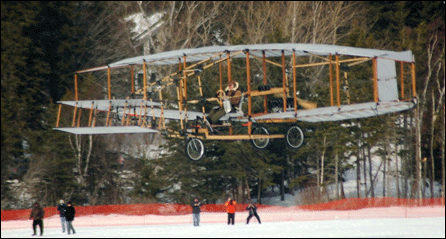
Silver Dart airborne over Baddeck Bay, NS - Feb. 22, 2009.
(Photo: M.B. Whitcomb)

Pilot Bjarni Tryggvason, Canadian Astronaut, skilfully flies the Silver Dart replica.
Feb. 22, 2009 (Photo: M.B. Whitcomb)
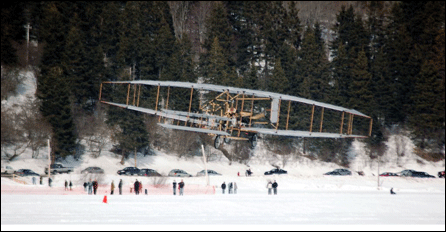
Silver Dart soars over the ice of Baddeck Bay recreating the historic February 23, 1909 flight by J.A. Douglas McCurdy of the Aerial Experiment Association. That flight was the first powered aircraft flight in Canada and the British Empire. Feb. 22, 2009 (Photo: M.B. Whitcomb)

Looking like a scene from a century ago, the Silver Dart replica amazes spectators gathered on the frozen surface of Baddeck Bay. This flight was covered by news media from across Canada as the first century of aviation is closed out with this historic flight. Feb. 22, 2009 (Photo: M.B. Whitcomb)
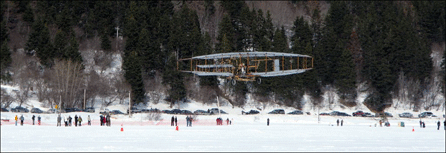
Silver Dart flying before entusiastic spectators that lined the ice and the roadway along Baddeck Bay. Feb. 22, 2009 (Photo: M.B. Whitcomb)
Additional reports of the flight of the Silver Dart replica are listed below:
- The Vancouver Sun: The Silver Dart Sputtered Into History
- CBC NewsWorld: Silver Dart Centenary (video)
- Halifax Chronicle-Herald: Origins of Flight
- Canadian Press: Silver Dart Replica Makes Five Flights Over Frozen Lake in Baddeck, NS
- Cape Breton Post: Silver Dart Takes Flight Again!
- Aviation.ca: Sabre and Silver Dart Make History - Again!
- Canadian Press: Flight of replica Silver Dart cancelled amid bad weather in Cape Breton
- Cape Breton Post: Pilot says Silver Dart flight rivals space shuttle trip
- CBC.ca: Stormy weather forces cancellation of Silver Dart flight - refers to bad weather on Feb. 23, 2009.
- Halifax Chronicle-Herald: No anniversary flight - Storm grounds Silver Dart replica on historic day
- Canada Post: Canada Post issues new stamp to honour First Flight in Canada
- Elmira NY-Star Gazette: Curtiss and crew gave Canada its first airplane flight. This detailed three page article concludes a series on Glenn Curtiss of the AEA. Written by historian Kirk W. House former director/curator of the Curtiss Museum in Hammondsport, the piece contains good details on the AEA, Curtiss, the Silver Dart and Douglas McCurdy.
- St. Catharines Standard: Silver lining for grounded Silver Dart.
- Cape Breton Post: Legacy Expansion Project Takes Flight
- Halifax Chronicle-Herald: Education system needs more kite flyers.
The video service, YouTube also has some video entries for the Silver Dart replica at Baddeck, NS:
- Silver Dart rolls out of hangar on to ice in Baddeck - this video shows a terrific closeup of the Silver Dart replica and many of the crew of dedicated builders of the aircraft.
- Silver Dart Centennial Flight - Baddeck 2009 - an amazing video of the Silver Dart replica in flight. (Video by: joadhenry)
- Silver Dart replica flies in Baddeck - this video captures the flight and the excitement of spectators as history is made.
Additional original photographs and the story of the flights from the perspective of the builders of the Silver Dart replica is found on their web site.
For detailed historical information on the Aerial Experiment Association and its members as well as the aerodromes of the AEA, use the navigation list on the right of the web site to explore the background of the members and their contributions to aviation.
Photographs by Marian Bell Whitcomb - no further distirbution or publication is authorized.
Story by Bob White (Member Historical Research Writers Association)
Silver Dart Replica Flies Into History Books
In December 1908 the Aerial Experiment Association completed the construction of Aerodrome 4 - the Silver Dart, in Hammondsport NY at the factory of Glenn H. Curtiss. The Silver Dart, the final airplane produced by the AEA, was test flown in Hammondsport in late December 1908 by chief designer Douglas McCurdy and by engine manufacturer Glenn Curtiss.
Curtiss had designed and built the earlier June Bug (Aerodrome 3) and flown it successfully for over one kilometre on July 4, 1908 to win the Scientific American Trophy for the first publicly witnessed flight of one kilometre in length.
Building on the highly publicized success of the June Bug, the Silver Dart incorporated all of the accumulated knowledge and best thinking of its designers.
Silver Dart being towed onto the ice for flight - Feb. 23, 1909.
After the successful trial flights of the Silver Dart in Hammondsport, the aerodrome was dismantled and shipped to Baddeck Nova Scotia where it flew off the ice on Bras d'or Lake on February 23, 1909. That flight was the first flight in Canada and the first in the British empire. It was truly an amazing accomplishment in the history of Canadian aviation.
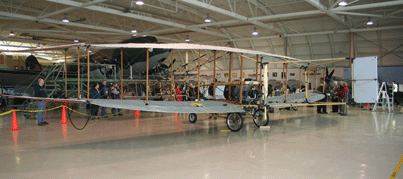
Silver Dart Replica at Canadian Warplane Heritage Museum prior to test flights, Feb. 6, 2009
In January of 2009, just one month over 100 years later, the modern aviation group AEA 2005, Inc., comprised of twenty-five historic flight volunteers from Welland, Ontario, completed a full scale replica of the original machine in a hangar of the Russell Aviation Group in Niagara Falls. Working from a set of original plans, the dedicated AEA 2005 crew worked for over five years to bring their dream to reality. It is a story of tremendous love for aviation and Canada's history.
Essentially the only difference between the replica and the original Silver Dart is the inclusion of foot controls, disc brakes, some basic instruments and the use of a 1947 aircraft engine of similar horsepower to the original Curtiss engine.
After completion in Niagara Falls, the plane was disassembled and shipped to the Canadian Warplane Heritage Museum in Hamilton, Ontario to be close to test runways at the Hamilton International Airport.
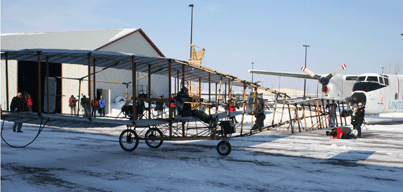
Silver Dart, with Bjarni Tryggvason as pilot, taxis for test flight, Feb. 6, 2009
On February 6, 2009 beginning at approximately 1:30 p.m. the Silver Dart replica, Canadian airplane C-IIGY, flew six brief but highly successful flights to demonstrate its airworthiness.
Former Canadian Astronaut Bjarni Tryggvason was at the controls and lifted the Silver Dart off with ease. His landings on each occasion were feather light. The first flight, on Runway 24 heading South-West, was over 3000 feet in length at a maximum altitude of three metres and lasted 50 seconds. Final touchdown occurred at 2:40 EST (19:40 Zulu). On the sixth and final flight of the afteroon the Silver Dart flew over 5,000 feet covering much of the 6,000 foot runway.
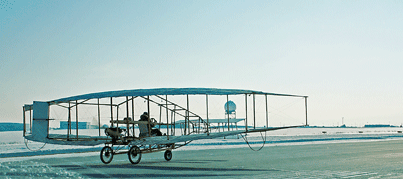
Silver Dart nears take off speed on main runway at Hamilton Airport, Feb. 6, 2009
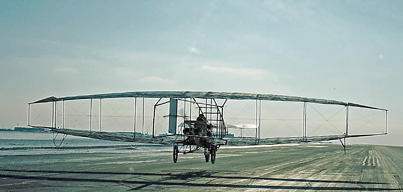
Silver Dart airborne on first flight of the day, Feb. 6, 2009. Six flights were completed.

Refueling the Silver Dart between flights. Pilot Bjarni Tryggvason smiles,
pleased with the handling of the aerodrome, as he confers with the flight support crew.

The Silver Dart at peak altitude on sixth and longest flight, Feb. 6, 2009.
The Silver Dart will now be disassembled and shipped to Baddeck Nova Scotia for the Centennary Celebrations of the flight of the original Silver Dart. On February 23, 2009, exactly one hundred years after Douglas McCurdy flew the Dart over Bras d'or Lake in a flight witnessed by Alexander Graham Bell and his wife Mabel, the other members of the AEA (Curtiss and Casey Baldwin) and hundreds of townsfolk from Baddeck, the Silver Dart replica will re-create history.
I was honoured to be a witness to this historic event by being present at the test flights of the Silver Dart replica on February 6, 2009. The hangar images of the Silver Dart and the Dart taxiing were taken at the Canadian Warplane Heritage Museum in Hamilton, Ontario. The three still images of the flight record the Silver Dart at high speed taxi and in flight on Runway 24 of the adjoining Hamilton International Airport. I took these images though the windshield of the official Hamilton International Airport escort vehicle following about 30 metres behind the Silver Dart travelling at 32 kilometres per hour . The image of Bjarni Tryggvasson conferencing with the flight support crew was taken during a refueling break on Runway 24.
Two videos showing the flight from dramatic points of view were taken by my close kiting friends Jim Anes and Carlos Simoes who also had special access to the flight.
The Jim Anes video shows the Silver Dart as it flies from right to left down the main runway. It is an amazing visual record of the fifth flight.
The Carlos Simoes video shows the Silver Dart from inside the other escort vehicle on the runway. This vehicle was driven by Doug Jermyn, head of the AEA 2005 Group that built the replica. On this video you hear the voice of Doug Jermyn calling the fifth flight as it happens. Background radio dialogue is from the Hamilton tower to the escort vehicles and an airplane that is circling waiting to land after the Dart's test flight. This is a dramatic video of the flight from just behind the aircraft.
Slide Show of the Flight Trials and Events of the Day:
Carlos Simoes has posted a complete slide show of the events of the day. Starting with the Silver Dart in the hangar early in the morning of Feb 6, 2009, the show takes you through the day with both slides and videos of each of the six flights. The slide show ends with the news media scrum and hangar celebration following the flights.
Links to News Media Coverage of the Event:
- Toronto Star: One Small Step for Aviation Buffs
- CBC.ca: Silver Dart Replica Flies at Hamilton Airport
- CTV.ca: Ex-astronaut flies replica Silver Dart
- CKCO-TV: Aviation history soars over Hamilton
- Hamilton Spectator: Magnificent Flying Machine
- Hamilton Spectator: Video - Silver Dart Makes Historic Flight Again
- Hamilton Spectator:
- Toronto Sun: Winging Into History
- Globe and Mail: Modern Silver Dart replicates history - for a few metres
- Canadian Press: Modern day version Silver Dart makes successful test run; next stop Baddeck, N.S.
- London Free Press: UWO prof achieves flight of a lifetime a full century later
- Welland Tribune: Wellander on Cloud 9 After Silver Dart Flight
- Brantford Expositor: Bell's dream taking flight again
- Aviation.ca: The Silver Dart Soars in Ontario
- AVweb.com: Silver Dart Replica Flies in Canada
The events that will take place in Baddeck Nova Scotia around the February 23, 2009 flight to mark the 100th Anniversary of the original Silver Dart flight can be found on the site of the Flight of the Silver Dart Centennial Celebration.
Details of the amazing group of builders, known as the AEA 2005 Inc., who recreated the Silver Dart are found on their web site dedicated to the Silver Dart project. This site is a detailed and very interesting account of their labour of love.
Finally, special thanks for our coverage of this event must go to Doug Jermyn and his wife Carol Harding who accorded Best-Breezes and the Historic Kiters Group incredible access to the Silver Dart during construction and on test flight day. Thank you Doug, Carol, Jack Minor, Ray Larsen, Don Feduck, James Griffith, Bjarni Tryggvason and Gerry Bettridge (Russell Aviation Group) for all you did to accommodate our coverage of this event.
________________
Other related reference sites:
- Glenn H. Curtiss Museum. Located in Hammondsport NY this museum is an outstanding site to visit for information on Glenn Curtiss, the Aerial Experiment Association and early flight.
- Parks Canada - Alexander Graham Bell National Historic Site. Located in Baddeck NS this museum is operated by Parks Canada and is dedicated to communicating the story of Alexander Graham Bell's wide ranging interests and inventive work, much of it undertaken right in Baddeck, Nova Scotia.
Story and photos by Bob White (Member Historical Research Writers Association).
Kite Flying - A World Wide Activity
A recent email from a close kite flyer friend of mine made me realize how small the world has become with modern travel and communication systems.
It is possible to use our computers to learn about events all over the world in real time. Television's video magic makes us feel as though we are at events as they happen. Streaming video and sites like YouTube allow us to experience what is going on no matter where it is happening. The ease of travel can take you from your home to the other side of the world in less than a day.
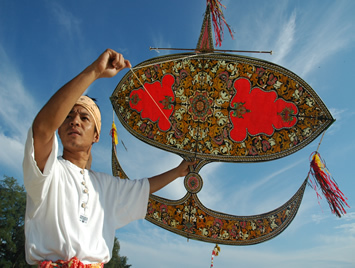 My friend is travelling to the famous kite festival in Pasir Gudang (Johor), Malaysia in a few days. Pasir Gudang is located on the mainland across from the island of Singapore.
My friend is travelling to the famous kite festival in Pasir Gudang (Johor), Malaysia in a few days. Pasir Gudang is located on the mainland across from the island of Singapore.
Held at the end of the second week in February each year, the Pasir Gudang kite festival is known around the world as an intersection point for kiters from around the world. At this festival, kite fliers from Europe, India, China, Australia, New Zealand, the United States and Canada will mingle with kiters flying traditional Malaysian "wau" kites. It is indeed a blend of all the best the world has to offer in a variety of kites defined by visitors from different global locales.
The Pasir Gudang Kite Museum is located here, on top of Kite Hill. It is the first kite museum in Malaysia and has a unique working windmill that generates enough electricity to supply the daily needs of the museum. What could be more appropriate for a kite museum than to use the wind to provide green energy.
Nor is this the only kite festival to take place in Malaysia. Malacca, the third smallest Malaysian state, located in the southern region of the Malay Peninsula, on the Straits of Malacca also recently hosted a major international kite festival. The Star Online in Malacca reported that "about 200 kite enthusiasts from all over the country gathered at the Dataran Pahlawan field in Bandar Hilir, Malacca, to take part in the Third Malaysia-China 2009 Kite Flying Festival recently". The festival was also attended by European flyers from as far away as Finland.
This is not the only location where kiting is flourishing in the large global community.
Recent news reports from around the world cited major kiting activity in every corner of the world.
India and Pakistan: recent reports of the major kite flying activity that is associated with the celebration of Utterayan and Makhar Sankranti (India) and Basant (Pakistan) have been streaming steadily from news agencies in the Asian sub-continent.
- India:
"May it be Republic Day or Independence Day or Makar Sakranti or Janamashtami, more and more people in north India are taking to kite flying on such days. In a way, kite flying is becoming a festival by itself. The Indian festival of Makar Sakranti is devoted to kite flying and fighting in some states. This year the festival was celebrated on January 14, with millions of people flying kites all over northern India.
The states of Bihar, Jharkhand, Gujarat, and some part of West Bengal, Rajasthan, Andhra Pradesh and the cities of Ahemdabad, Baroda, Jaipur, Dhanbad and Hyderabad are particularly notable for their kite fighting festivals."
From: MyNews.in
Also: Kites colour the skies and unite the world
- Pakistan: A kite fighting ban imposed by the Pakistan Supreme Court has been effect for several years now due to the number of injuries and deaths that have occurred due to kite flying. In Pakistan, as in India, kite fighting is the ultimate kite flying challenge. Kiters duel it out in the skies cutting one another's kited from the skies using glass and chemically coated kite line to assist in severing the kite of an opponent and thus win the battle. The details surrounding this ban and some of the background can be found here on the Best-Breezes site by using the Search function to see previous articles. However, this year there were calls to lift the ban and legitimize the kite flying that continues in spite of the ruling against the use of sharp kite line. The Daily Times of Lahore reported:
"According to a poll conducted by the channel, approximately 75 percent of the city’s residents favoured kite flying in celebration of the spring festival. Residents say the ban on kite flying not only deprived the people of celebrating and enjoying a festive occasion but also adversely affected the developing industry of manufacturing kite-related products, the channel reported. Overall, the Punjab government’s initiative to consider lifting the ban was welcomed by the public, it added."
Australian and New Zealand kite festivals are in full swing now as the Southern Hemisphere is enjoying summer. These two locales have produced some of the most innovative modern kites to grace the skies at kite festivals in the past decade. Recently, the Tip-Top Kite Day was held in ChristChurch, NZ and featured international kiters in attendance from as far away as The Netherlands. So it is clear that kiting is flourishing in this region as well.
Europe has a number of outstanding festivals: Dieppe France, Bristol in Great Britain, Schveningen in The Netherlands and Fano in Denmark are well known gathering spots for international kite fliers.
North America has a large number of festivals of note: the Niagara International Kite Festival in Niagara Falls, NY; Wildwood in New Jersey; the Smithsonian Kite Festival in Washington, D.C.; Sunfest in Ocean City, Maryland; the Washington State Kite Festival and Dieppe, New Brunswick are among the many events in this continent that attract noted fliers from around the world.
Each of these events has a major impact on the dissemination of current kite knowledge and innovation. In addition, the kites in the sky bring delight to local spectators and tourists who increasingly add these events to their itineraries.
The list could go on and on. However, just using these examples it is safe to conclude that kite flying as a world wide activity is alive and well. The ability to use modern communication keeps us in touch with these events as they happen. Modern transportation allows us to place ourselves on these noted kite fields with the best kiters in the world. It is a small world and somewhere a kite is flying in the sky at all times.
What is your favorite type of kite?
I have recently engaged in a series of discussions with kitefliers that I know to see what first attracted them to kiting. Many stated that they entered the kite hobby as an adult by purchasing a dual line kite after seeing one in flight and becoming intrigued by trying to develop the skills to fly a sport kite.
Later, most stated, they moved to other types of kites as their interests changed in the hobby. That prompted me to wonder: What is your favorite type of kite?
Take the survey and lets see what takes place over the next month or so in terms of reader responses.





